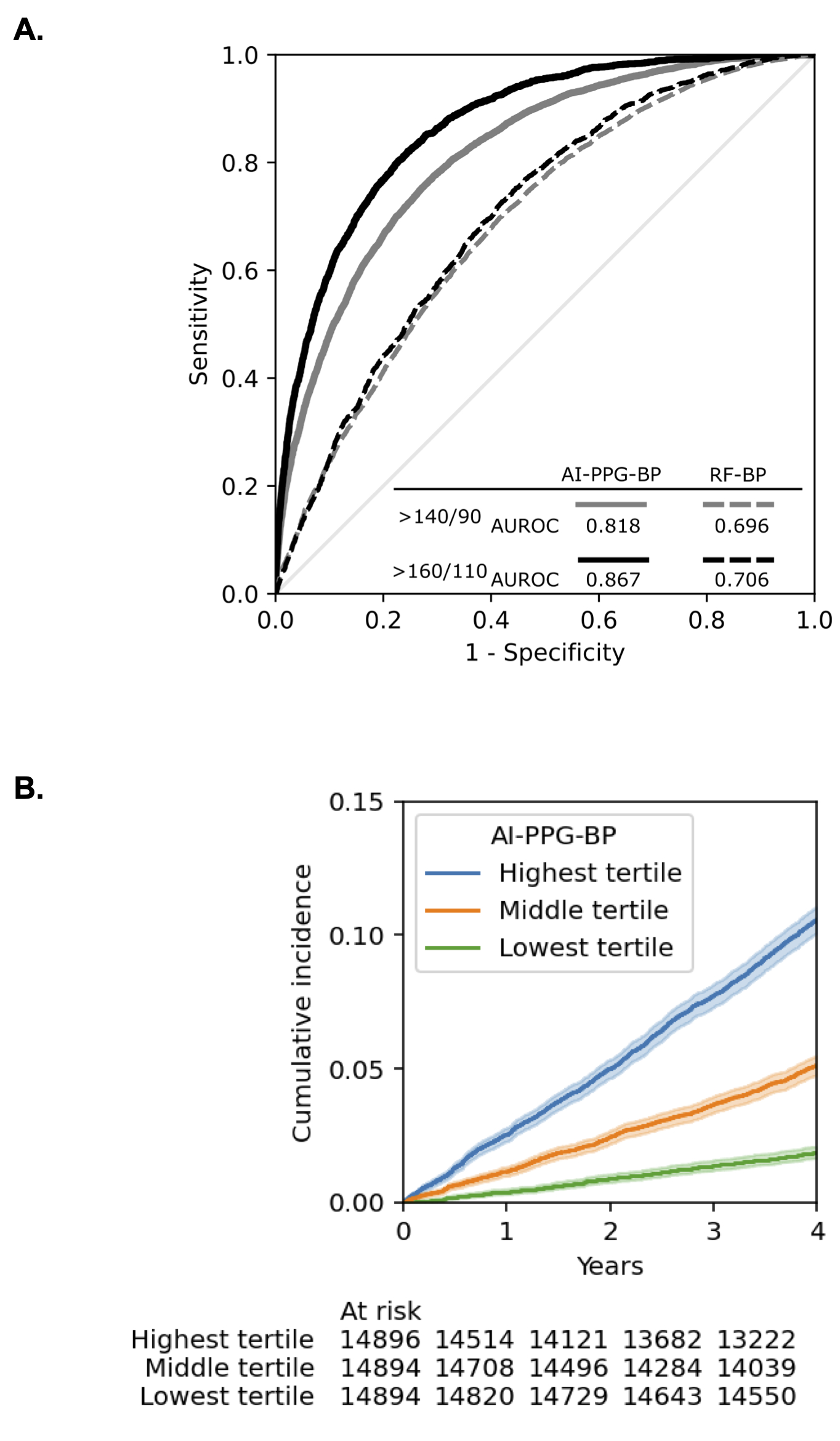Final ID: 4144024
AI-Enabled Photoplethysmography Can Help Detect Elevated Blood Pressure And Predict Near-Term Incidence Of Hypertension
Abstract Body (Do not enter title and authors here): Background: Improving detection of individuals with undiagnosed hypertension (HTN) and those at risk of developing HTN are global priorities. Sensors within smartphone and consumer devices capable of photoplethysmography (PPG) may provide novel tools to support these efforts.
Aims: Determine risk of baseline elevated blood pressure (BP) and incident HTN using a deep learning model (AI-PPG-BP) derived from PPG waveforms.
Methods: Using the UK Biobank dataset, participants aged 40-74 without previously known HTN or cardiovascular disease were split into train (N=58,216), tune (N=31,671), and test (N=44,684) sets based on location of the data collection site. We trained a 1D convolutional neural network incorporating age, sex, weight and height to estimate BP from PPG waveforms (obtained from a 10-15 second recording with an infra-red sensor). Performance of model-predicted BP (AI-PPG-BP) in detecting elevated BP at baseline was compared to a logistic regression model using risk factors of age, sex, BMI, parental HTN, and smoking status (RF-BP). Additionally, we developed a Cox proportional hazards model to predict 4-year incident HTN (AI-PPG-HTN), using AI-PPG-BP as well as the risk factors. Model performance for incident HTN was compared to a Cox model using risk factors alone (RF-HTN), as well as the Framingham HTN risk score.
Results: In the test set, AI-PPG-BP detected elevated baseline SBP/DBP of >140/90 (n=15,696, 35.1%) and >160/110 mmHg (n=3,546, 7.9%) with AUROCs of 0.818 [95%CI: 0.814-0.822] and 0.867 [0.861-0.872], respectively, outperforming RF-BP (AUROC 0.696 [0.691-0.700] and 0.706 [0.698-0.714]). AI-PPG-BP stratified cumulative incidence of HTN, and was significantly associated with risk of incident HTN (HR per SD: 1.48 [1.41-1.54], p<0.001) after adjusting for risk factors. The c-statistic for AI-PPG-HTN (0.733 [0.725, 0.741]) outperformed RF-HTN (0.711 [0.703, 0.721]); and was non-inferior to the Framingham HTN risk score (0.736 [0.728, 0.745]; prespecified non-inferiority margin 0.010, p<0.01).
Conclusion: A deep learning model, AI-PPG-BP, may be able to serve as a useful pre-screener by helping to detect elevated BP and stratifying risk of near-term, incident HTN using finger PPG.
Aims: Determine risk of baseline elevated blood pressure (BP) and incident HTN using a deep learning model (AI-PPG-BP) derived from PPG waveforms.
Methods: Using the UK Biobank dataset, participants aged 40-74 without previously known HTN or cardiovascular disease were split into train (N=58,216), tune (N=31,671), and test (N=44,684) sets based on location of the data collection site. We trained a 1D convolutional neural network incorporating age, sex, weight and height to estimate BP from PPG waveforms (obtained from a 10-15 second recording with an infra-red sensor). Performance of model-predicted BP (AI-PPG-BP) in detecting elevated BP at baseline was compared to a logistic regression model using risk factors of age, sex, BMI, parental HTN, and smoking status (RF-BP). Additionally, we developed a Cox proportional hazards model to predict 4-year incident HTN (AI-PPG-HTN), using AI-PPG-BP as well as the risk factors. Model performance for incident HTN was compared to a Cox model using risk factors alone (RF-HTN), as well as the Framingham HTN risk score.
Results: In the test set, AI-PPG-BP detected elevated baseline SBP/DBP of >140/90 (n=15,696, 35.1%) and >160/110 mmHg (n=3,546, 7.9%) with AUROCs of 0.818 [95%CI: 0.814-0.822] and 0.867 [0.861-0.872], respectively, outperforming RF-BP (AUROC 0.696 [0.691-0.700] and 0.706 [0.698-0.714]). AI-PPG-BP stratified cumulative incidence of HTN, and was significantly associated with risk of incident HTN (HR per SD: 1.48 [1.41-1.54], p<0.001) after adjusting for risk factors. The c-statistic for AI-PPG-HTN (0.733 [0.725, 0.741]) outperformed RF-HTN (0.711 [0.703, 0.721]); and was non-inferior to the Framingham HTN risk score (0.736 [0.728, 0.745]; prespecified non-inferiority margin 0.010, p<0.01).
Conclusion: A deep learning model, AI-PPG-BP, may be able to serve as a useful pre-screener by helping to detect elevated BP and stratifying risk of near-term, incident HTN using finger PPG.
More abstracts on this topic:
A dual probe ultrasound vector Doppler method for a robust and reliable estimation of blood flow volume and pulse wave velocity on the carotid artery
Mattesini Paolo, Ramalli Alessandro, Travagliati Marco, Confalonieri Federica, Baldasarre Leonardo
A Machine Learning Algorithm to Detect Pediatric Supraventricular Tachycardia Risk from Baseline ECGsArezoumand Amirhossein, Danala Gopichandh, Masnadi Khiabani Parisa, Ebert David, Behere Shashank

